
POSTACIE Painters
Orazio Gentileschi (1563–1639) – an intimate realist prone to rowdiness
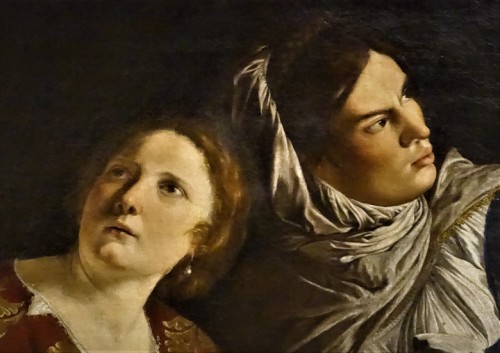
Orazio Gentileschi, Judith and Her Maidservant with the Head of Holofernes, fragment, Musei Vaticani –Pinacoteca Vaticana
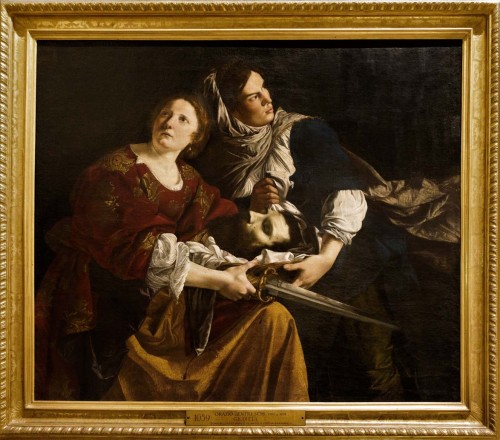
Orazio Gentileschi, Judith and Her Maidservant with the Head of Holofernes, Musei Vaticani – Pinacoteca Vaticana

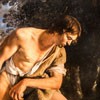
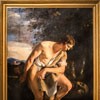
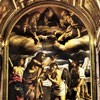
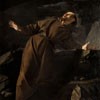

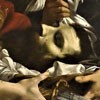
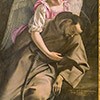


However, soon profound gesticulations were replaced in Orazio’s art by simplified composition and intense chiaroscuro, which were displayed to the fullest in his intimate paintings, destined for private clients. The reason for the change in his way of painting was meeting Caravaggio around the year 1600 and becoming familiar with his works – more and more controversial and surprising with their almost revolutionary literality, realism and expression. Under their influence, the almost 40-year old artist became the most loyal imitator and continuator of his nearly eight years younger friend. He took over not only the style of his works, but also their iconography, of which an example is the painting David with the Head of Goliath, in which the artist used the same as Caravaggio had in a painting with the same title, thoughtful sorrow of the main character looking at the defeated enemy without triumph. Yet despite that, Orazio was able to give his paintings a mark of his own, autonomous style. He skillfully balanced on the border of intimacy and realism, which is well expressed by, among others, his Madonna and Child. From this holy scene the painter brings out a moment of tenderness which is shared between every mother and child. A delicate, but set in a strong contrast chiaroscuro additionally strengthens the aura of the painting.

Gentileschi followed the steps of Caravaggio outside artistic matters as well, as the latter was known in Rome not only for the widely admired paintings, but also for his rowdiness and drunkenness. Gentileschi joined him and a few others making up quite a team, fond of nightly escapades and notorious among the inhabitants of the Eternal City. That is why Orazio did not leave a good reputation behind. He was considered a quarrelsome and difficult man, prone to constant rows and derisions. His especially unfavorable, yet subjective description was given by Giovanni Baglione – an average painter, but an outstanding chronicler of the then artistic Boehme. He did not like Gentileschi, which should come as no surprise. Very unflattering insults formulated towards him as well as scathing poems even became a reason for suit for libel, with which three braggarts (Caravaggio, Gentileschi and Onorio Longhi) were charged by Baglione. From the preserved text of the trial it turns out that Orazio squirmed like a worm, in order not to have his rowdy escapade become a reason of accusing him of something more serious – of sacrilege. In a letter which Baglione cited to the court, Gentileschi rather bluntly thanks for a gift (a metal medallion), which Baglione sent him after returning from a trip to Loreto, writing that he should hang it on his…balls.
Gentileschi had six children, of whom two died early, but the two oldest followed in the footsteps of his father. From assistants who were tasked with mixing paints and modeling they slowly became painters. And while the son, Francesco is remembered in the annals of art as a quite talented continuator and executor of smaller parts of Orazio’s paintings, the daughter Artemisia (Artemisia Gentileschi) proved to be exceptionally gifted in the field of drawing, becoming perhaps the first significant woman painter in the world. After a court trial over rape, which appalled the whole artistic community, and which was perpetrated by a friend and collaborator of Orazio, Agostino Tassi, both the father and the daughter leave Rome. His path first leads him to Genoa, later to Paris and finally to London, where for many years he works at the court of Charles I and where ultimately he dies.

The most important works of Orazio Gentileschi in Rome:
Zgodnie z art. 13 ust. 1 i ust. 2 rozporządzenia Parlamentu Europejskiego i Rady (UE) 2016/679 z 27 kwietnia 2016 r. w sprawie ochrony osób fizycznych w związku z przetwarzaniem danych osobowych i w sprawie swobodnego przepływu takich danych oraz uchylenia dyrektywy 95/46/WE (RODO), informujemy, że Administratorem Pani/Pana danych osobowych jest firma: Econ-sk GmbH, Billbrookdeich 103, 22113 Hamburg, Niemcy
Przetwarzanie Pani/Pana danych osobowych będzie się odbywać na podstawie art. 6 RODO i w celu marketingowym Administrator powołuje się na prawnie uzasadniony interes, którym jest zbieranie danych statystycznych i analizowanie ruchu na stronie internetowej. Podanie danych osobowych na stronie internetowej http://roma-nonpertutti.com/ jest dobrowolne.
| Params | |
|---|---|
| 0 | |
| 1 | |
| 2 | |
| 3 | |
| 4 | |
| 5 | |
| Params | |
|---|---|
| 0 | |
| 1 | |
| 2 | |
| 3 | |
| 4 | |
| 5 | |
| 6 | |
| 7 | |
| 8 | |
| 9 | |
| 10 | |
| 11 | |
| 12 | |
| Params | |
|---|---|
| 0 | |
| 1 | |
| 2 | |
| 3 | |
| 4 | |
| 5 | |
| 6 | |
| 7 | |
| 8 | |
| 9 | |
| 10 | |
| 11 | |
| 12 | |
| Params | |
|---|---|
| 0 | |
| Params | |
|---|---|
| 0 | |
| 1 | |
| 2 | |
| 3 | |
| 4 | |
| 5 | |
| 6 | |
| 7 | |
| 8 | |
| 9 | |
| 10 | |
| 11 | |
| 12 | |
| Params | |
|---|---|
| 0 | |
| 1 | |
| 2 | |
| 3 | |
| 4 | |
| 5 | |
| 6 | |
| 7 | |
| 8 | |
| 9 | |
| 10 | |
| 11 | |
| 12 | |
| Params | |
|---|---|
| 0 | |
| 1 | |
| 2 | |
| 3 | |
| 4 | |
| 5 | |
| 6 | |
| 7 | |
| 8 | |
| 9 | |
| 10 | |
| 11 | |
| 12 | |
| Params | |
|---|---|
| 0 | |
| 1 | |
| 2 | |
| 3 | |
| 4 | |
| 5 | |
| 6 | |
| 7 | |
| 8 | |
| 9 | |
| 10 | |
| 11 | |
| 12 | |
| 13 | |
| 14 | |
| 15 | |
| 16 | |
| 17 | |
| 18 | |
select * from `articles_categories` where (`parent_id` is null and `status` = 'ACTIVE')4.11msbaza5943_roma| Metadata | |
|---|---|
| Bindings |
|
| Hints |
|
select * from `attributes` where (`table` = 'articles_categories')380μsbaza5943_roma| Metadata | |
|---|---|
| Bindings |
|
| Hints |
|
select * from `attributes_varchar` where `attribute_id` = '1' and `entity_id` = '1' and `lang` = 'en'420μsbaza5943_roma| Metadata | |
|---|---|
| Bindings |
|
| Hints |
|
select * from `articles_categories` where (`parent_id` = '1' and `status` = 'ACTIVE')380μsbaza5943_roma| Metadata | |
|---|---|
| Bindings |
|
| Hints |
|
select * from `attributes` where (`table` = 'articles_categories')370μsbaza5943_roma| Metadata | |
|---|---|
| Bindings |
|
| Hints |
|
select * from `attributes_varchar` where `attribute_id` = '1' and `entity_id` = '2' and `lang` = 'en'360μsbaza5943_roma| Metadata | |
|---|---|
| Bindings |
|
| Hints |
|
select * from `articles_categories` where (`parent_id` = '2' and `status` = 'ACTIVE')580μsbaza5943_roma| Metadata | |
|---|---|
| Bindings |
|
| Hints |
|
select * from `attributes` where (`table` = 'articles_categories')350μsbaza5943_roma| Metadata | |
|---|---|
| Bindings |
|
| Hints |
|
select * from `attributes_varchar` where `attribute_id` = '1' and `entity_id` = '3' and `lang` = 'en'350μsbaza5943_roma| Metadata | |
|---|---|
| Bindings |
|
| Hints |
|
select * from `articles_categories` where (`parent_id` = '3' and `status` = 'ACTIVE')380μsbaza5943_roma| Metadata | |
|---|---|
| Bindings |
|
| Hints |
|
select * from `attributes` where (`table` = 'articles_categories')340μsbaza5943_roma| Metadata | |
|---|---|
| Bindings |
|
| Hints |
|
select * from `attributes_varchar` where `attribute_id` = '1' and `entity_id` = '4' and `lang` = 'en'310μsbaza5943_roma| Metadata | |
|---|---|
| Bindings |
|
| Hints |
|
select * from `articles_categories` where (`parent_id` = '4' and `status` = 'ACTIVE')430μsbaza5943_roma| Metadata | |
|---|---|
| Bindings |
|
| Hints |
|
select * from `attributes` where (`table` = 'articles_categories')360μsbaza5943_roma| Metadata | |
|---|---|
| Bindings |
|
| Hints |
|
select * from `attributes_varchar` where `attribute_id` = '1' and `entity_id` = '5' and `lang` = 'en'360μsbaza5943_roma| Metadata | |
|---|---|
| Bindings |
|
| Hints |
|
select * from `articles_categories` where (`parent_id` = '5' and `status` = 'ACTIVE')370μsbaza5943_roma| Metadata | |
|---|---|
| Bindings |
|
| Hints |
|
select * from `attributes` where (`table` = 'articles_categories')370μsbaza5943_roma| Metadata | |
|---|---|
| Bindings |
|
| Hints |
|
select * from `attributes_varchar` where `attribute_id` = '1' and `entity_id` = '8' and `lang` = 'en'360μsbaza5943_roma| Metadata | |
|---|---|
| Bindings |
|
| Hints |
|
select * from `articles_categories` where (`parent_id` = '8' and `status` = 'ACTIVE')380μsbaza5943_roma| Metadata | |
|---|---|
| Bindings |
|
| Hints |
|
select * from `attributes` where (`table` = 'articles_categories')360μsbaza5943_roma| Metadata | |
|---|---|
| Bindings |
|
| Hints |
|
select * from `attributes_varchar` where `attribute_id` = '1' and `entity_id` = '9' and `lang` = 'en'410μsbaza5943_roma| Metadata | |
|---|---|
| Bindings |
|
| Hints |
|
select * from `articles_categories` where (`parent_id` = '9' and `status` = 'ACTIVE')460μsbaza5943_roma| Metadata | |
|---|---|
| Bindings |
|
| Hints |
|
select * from `attributes` where (`table` = 'articles_categories')350μsbaza5943_roma| Metadata | |
|---|---|
| Bindings |
|
| Hints |
|
select * from `attributes_varchar` where `attribute_id` = '1' and `entity_id` = '10' and `lang` = 'en'520μsbaza5943_roma| Metadata | |
|---|---|
| Bindings |
|
| Hints |
|
select * from `articles_categories` where (`parent_id` = '10' and `status` = 'ACTIVE')380μsbaza5943_roma| Metadata | |
|---|---|
| Bindings |
|
| Hints |
|
select * from `attributes` where (`table` = 'articles_categories')600μsbaza5943_roma| Metadata | |
|---|---|
| Bindings |
|
| Hints |
|
select * from `attributes_varchar` where `attribute_id` = '1' and `entity_id` = '11' and `lang` = 'en'380μsbaza5943_roma| Metadata | |
|---|---|
| Bindings |
|
| Hints |
|
select * from `articles_categories` where (`parent_id` = '11' and `status` = 'ACTIVE')440μsbaza5943_roma| Metadata | |
|---|---|
| Bindings |
|
| Hints |
|
select * from `attributes` where (`table` = 'articles_categories')350μsbaza5943_roma| Metadata | |
|---|---|
| Bindings |
|
| Hints |
|
select * from `attributes_varchar` where `attribute_id` = '1' and `entity_id` = '12' and `lang` = 'en'360μsbaza5943_roma| Metadata | |
|---|---|
| Bindings |
|
| Hints |
|
select * from `articles_categories` where (`parent_id` = '12' and `status` = 'ACTIVE')500μsbaza5943_roma| Metadata | |
|---|---|
| Bindings |
|
| Hints |
|
select * from `attributes` where (`table` = 'articles_categories')360μsbaza5943_roma| Metadata | |
|---|---|
| Bindings |
|
| Hints |
|
select * from `attributes_varchar` where `attribute_id` = '1' and `entity_id` = '13' and `lang` = 'en'440μsbaza5943_roma| Metadata | |
|---|---|
| Bindings |
|
| Hints |
|
select * from `articles_categories` where (`parent_id` = '13' and `status` = 'ACTIVE')430μsbaza5943_roma| Metadata | |
|---|---|
| Bindings |
|
| Hints |
|
select * from `attributes` where (`table` = 'articles_categories')390μsbaza5943_roma| Metadata | |
|---|---|
| Bindings |
|
| Hints |
|
select * from `attributes_varchar` where `attribute_id` = '1' and `entity_id` = '14' and `lang` = 'en'370μsbaza5943_roma| Metadata | |
|---|---|
| Bindings |
|
| Hints |
|
select * from `articles_categories` where (`parent_id` = '14' and `status` = 'ACTIVE')3.65msbaza5943_roma| Metadata | |
|---|---|
| Bindings |
|
| Hints |
|
select * from `attributes` where (`table` = 'articles_categories')360μsbaza5943_roma| Metadata | |
|---|---|
| Bindings |
|
| Hints |
|
select * from `attributes_varchar` where `attribute_id` = '1' and `entity_id` = '15' and `lang` = 'en'540μsbaza5943_roma| Metadata | |
|---|---|
| Bindings |
|
| Hints |
|
select * from `articles_categories` where (`parent_id` = '15' and `status` = 'ACTIVE')370μsbaza5943_roma| Metadata | |
|---|---|
| Bindings |
|
| Hints |
|
select * from `attributes` where (`table` = 'articles_categories')360μsbaza5943_roma| Metadata | |
|---|---|
| Bindings |
|
| Hints |
|
select * from `attributes_varchar` where `attribute_id` = '1' and `entity_id` = '16' and `lang` = 'en'350μsbaza5943_roma| Metadata | |
|---|---|
| Bindings |
|
| Hints |
|
select * from `articles_categories` where (`parent_id` = '16' and `status` = 'ACTIVE')450μsbaza5943_roma| Metadata | |
|---|---|
| Bindings |
|
| Hints |
|
select * from `attributes` where (`table` = 'articles_categories')360μsbaza5943_roma| Metadata | |
|---|---|
| Bindings |
|
| Hints |
|
select * from `attributes_varchar` where `attribute_id` = '1' and `entity_id` = '17' and `lang` = 'en'390μsbaza5943_roma| Metadata | |
|---|---|
| Bindings |
|
| Hints |
|
select * from `articles_categories` where (`parent_id` = '17' and `status` = 'ACTIVE')580μsbaza5943_roma| Metadata | |
|---|---|
| Bindings |
|
| Hints |
|
select * from `attributes` where (`table` = 'articles_categories')550μsbaza5943_roma| Metadata | |
|---|---|
| Bindings |
|
| Hints |
|
select * from `attributes_varchar` where `attribute_id` = '1' and `entity_id` = '18' and `lang` = 'en'310μsbaza5943_roma| Metadata | |
|---|---|
| Bindings |
|
| Hints |
|
select * from `articles_categories` where (`parent_id` = '18' and `status` = 'ACTIVE')390μsbaza5943_roma| Metadata | |
|---|---|
| Bindings |
|
| Hints |
|
select * from `attributes` where (`table` = 'articles_categories')380μsbaza5943_roma| Metadata | |
|---|---|
| Bindings |
|
| Hints |
|
select * from `attributes_varchar` where `attribute_id` = '1' and `entity_id` = '19' and `lang` = 'en'360μsbaza5943_roma| Metadata | |
|---|---|
| Bindings |
|
| Hints |
|
select * from `articles_categories` where (`parent_id` = '19' and `status` = 'ACTIVE')380μsbaza5943_roma| Metadata | |
|---|---|
| Bindings |
|
| Hints |
|
select * from `attributes` where (`table` = 'articles_categories')350μsbaza5943_roma| Metadata | |
|---|---|
| Bindings |
|
| Hints |
|
select * from `attributes_varchar` where `attribute_id` = '1' and `entity_id` = '20' and `lang` = 'en'570μsbaza5943_roma| Metadata | |
|---|---|
| Bindings |
|
| Hints |
|
select * from `articles_categories` where (`parent_id` = '20' and `status` = 'ACTIVE')380μsbaza5943_roma| Metadata | |
|---|---|
| Bindings |
|
| Hints |
|
select * from `attributes` where (`table` = 'articles_categories')370μsbaza5943_roma| Metadata | |
|---|---|
| Bindings |
|
| Hints |
|
select * from `attributes_varchar` where `attribute_id` = '1' and `entity_id` = '21' and `lang` = 'en'350μsbaza5943_roma| Metadata | |
|---|---|
| Bindings |
|
| Hints |
|
select * from `articles_categories` where (`parent_id` = '21' and `status` = 'ACTIVE')380μsbaza5943_roma| Metadata | |
|---|---|
| Bindings |
|
| Hints |
|
select * from `attributes` where (`table` = 'articles_categories')350μsbaza5943_roma| Metadata | |
|---|---|
| Bindings |
|
| Hints |
|
select * from `attributes_varchar` where `attribute_id` = '1' and `entity_id` = '22' and `lang` = 'en'440μsbaza5943_roma| Metadata | |
|---|---|
| Bindings |
|
| Hints |
|
select * from `articles_categories` where (`parent_id` = '22' and `status` = 'ACTIVE')380μsbaza5943_roma| Metadata | |
|---|---|
| Bindings |
|
| Hints |
|
select * from `attributes` where (`table` = 'articles_categories')360μsbaza5943_roma| Metadata | |
|---|---|
| Bindings |
|
| Hints |
|
select * from `attributes_varchar` where `attribute_id` = '1' and `entity_id` = '23' and `lang` = 'en'540μsbaza5943_roma| Metadata | |
|---|---|
| Bindings |
|
| Hints |
|
select * from `articles_categories` where (`parent_id` = '23' and `status` = 'ACTIVE')570μsbaza5943_roma| Metadata | |
|---|---|
| Bindings |
|
| Hints |
|
select * from `attributes` where (`table` = 'articles_categories')410μsbaza5943_roma| Metadata | |
|---|---|
| Bindings |
|
| Hints |
|
select * from `attributes_varchar` where `attribute_id` = '1' and `entity_id` = '24' and `lang` = 'en'980μsbaza5943_roma| Metadata | |
|---|---|
| Bindings |
|
| Hints |
|
select * from `articles_categories` where (`parent_id` = '24' and `status` = 'ACTIVE')380μsbaza5943_roma| Metadata | |
|---|---|
| Bindings |
|
| Hints |
|
select * from `attributes` where (`table` = 'articles_categories')370μsbaza5943_roma| Metadata | |
|---|---|
| Bindings |
|
| Hints |
|
select * from `attributes_varchar` where `attribute_id` = '1' and `entity_id` = '25' and `lang` = 'en'540μsbaza5943_roma| Metadata | |
|---|---|
| Bindings |
|
| Hints |
|
select * from `articles_categories` where (`parent_id` = '25' and `status` = 'ACTIVE')420μsbaza5943_roma| Metadata | |
|---|---|
| Bindings |
|
| Hints |
|
select * from `attributes` where (`table` = 'articles_categories')660μsbaza5943_roma| Metadata | |
|---|---|
| Bindings |
|
| Hints |
|
select * from `attributes_varchar` where `attribute_id` = '1' and `entity_id` = '26' and `lang` = 'en'1.02msbaza5943_roma| Metadata | |
|---|---|
| Bindings |
|
| Hints |
|
select * from `articles_categories` where (`parent_id` = '26' and `status` = 'ACTIVE')390μsbaza5943_roma| Metadata | |
|---|---|
| Bindings |
|
| Hints |
|
select * from `attributes` where (`table` = 'articles_categories')690μsbaza5943_roma| Metadata | |
|---|---|
| Bindings |
|
| Hints |
|
select * from `attributes_varchar` where `attribute_id` = '1' and `entity_id` = '27' and `lang` = 'en'620μsbaza5943_roma| Metadata | |
|---|---|
| Bindings |
|
| Hints |
|
select * from `articles_categories` where (`parent_id` = '27' and `status` = 'ACTIVE')1.08msbaza5943_roma| Metadata | |
|---|---|
| Bindings |
|
| Hints |
|
select * from `attributes` where (`table` = 'articles_categories')380μsbaza5943_roma| Metadata | |
|---|---|
| Bindings |
|
| Hints |
|
select * from `attributes_varchar` where `attribute_id` = '1' and `entity_id` = '28' and `lang` = 'en'890μsbaza5943_roma| Metadata | |
|---|---|
| Bindings |
|
| Hints |
|
select * from `articles_categories` where (`parent_id` = '28' and `status` = 'ACTIVE')1.03msbaza5943_roma| Metadata | |
|---|---|
| Bindings |
|
| Hints |
|
select * from `attributes` where (`table` = 'articles_categories')380μsbaza5943_roma| Metadata | |
|---|---|
| Bindings |
|
| Hints |
|
select * from `attributes_varchar` where `attribute_id` = '1' and `entity_id` = '29' and `lang` = 'en'490μsbaza5943_roma| Metadata | |
|---|---|
| Bindings |
|
| Hints |
|
select * from `articles_categories` where (`parent_id` = '29' and `status` = 'ACTIVE')410μsbaza5943_roma| Metadata | |
|---|---|
| Bindings |
|
| Hints |
|
select * from `settings`380μsbaza5943_roma| Metadata | |
|---|---|
| Hints |
|
select * from `articles` where `id` = '73' and `articles`.`deleted_at` is null9.89msbaza5943_roma| Metadata | |
|---|---|
| Bindings |
|
| Hints |
|
select * from `attributes` where (`table` = 'articles')690μsbaza5943_roma| Metadata | |
|---|---|
| Bindings |
|
| Hints |
|
select * from `attributes_varchar` where `attribute_id` = '2' and `entity_id` = '73' and `lang` = 'en'680μsbaza5943_roma| Metadata | |
|---|---|
| Bindings |
|
| Hints |
|
select * from `attributes_text` where `attribute_id` = '3' and `entity_id` = '73' and `lang` = 'en'650μsbaza5943_roma| Metadata | |
|---|---|
| Bindings |
|
| Hints |
|
select * from `attributes_text` where `attribute_id` = '6' and `entity_id` = '73' and `lang` = 'en'530μsbaza5943_roma| Metadata | |
|---|---|
| Bindings |
|
| Hints |
|
select * from `urls` where `table` = 'articles' and `entity_id` = '73'2.54msbaza5943_roma| Metadata | |
|---|---|
| Bindings |
|
| Hints |
|
select * from `articles` where `articles`.`id` = '73' and `articles`.`deleted_at` is null limit 1580μsbaza5943_roma| Metadata | |
|---|---|
| Bindings |
|
| Hints |
|
select `articles_categories`.*, `articles_categories_join`.`article_id` as `pivot_article_id`, `articles_categories_join`.`category_id` as `pivot_category_id` from `articles_categories` inner join `articles_categories_join` on `articles_categories`.`id` = `articles_categories_join`.`category_id` where `articles_categories_join`.`article_id` = '73'570μsbaza5943_roma| Metadata | |
|---|---|
| Bindings |
|
select * from `articles_categories` where `articles_categories`.`id` = '5' limit 1500μsbaza5943_roma| Metadata | |
|---|---|
| Bindings |
|
| Hints |
|
select * from `attributes` where `key` in ('name') and (`table` = 'articles_categories')340μsbaza5943_roma| Metadata | |
|---|---|
| Bindings |
|
| Hints |
|
select * from `attributes_varchar` where `attribute_id` = '1' and `entity_id` = '5' and `lang` = 'en'780μsbaza5943_roma| Metadata | |
|---|---|
| Bindings |
|
| Hints |
|
select * from `articles_categories` where `articles_categories`.`id` = '2' limit 1410μsbaza5943_roma| Metadata | |
|---|---|
| Bindings |
|
| Hints |
|
select * from `articles_photos` where `article_id` = '73'1.5msbaza5943_roma| Metadata | |
|---|---|
| Bindings |
|
| Hints |
|
select * from `attributes` where (`table` = 'articles_photos')460μsbaza5943_roma| Metadata | |
|---|---|
| Bindings |
|
| Hints |
|
select * from `attributes_varchar` where `attribute_id` = '5' and `entity_id` = '1202' and `lang` = 'en'1.19msbaza5943_roma| Metadata | |
|---|---|
| Bindings |
|
| Hints |
|
select * from `attributes` where (`table` = 'articles_photos')550μsbaza5943_roma| Metadata | |
|---|---|
| Bindings |
|
| Hints |
|
select * from `attributes_varchar` where `attribute_id` = '5' and `entity_id` = '1203' and `lang` = 'en'400μsbaza5943_roma| Metadata | |
|---|---|
| Bindings |
|
| Hints |
|
select * from `attributes` where (`table` = 'articles_photos')1.5msbaza5943_roma| Metadata | |
|---|---|
| Bindings |
|
| Hints |
|
select * from `attributes_varchar` where `attribute_id` = '5' and `entity_id` = '1205' and `lang` = 'en'450μsbaza5943_roma| Metadata | |
|---|---|
| Bindings |
|
| Hints |
|
select * from `attributes` where (`table` = 'articles_photos')1.03msbaza5943_roma| Metadata | |
|---|---|
| Bindings |
|
| Hints |
|
select * from `attributes_varchar` where `attribute_id` = '5' and `entity_id` = '1206' and `lang` = 'en'520μsbaza5943_roma| Metadata | |
|---|---|
| Bindings |
|
| Hints |
|
select * from `attributes` where (`table` = 'articles_photos')1.04msbaza5943_roma| Metadata | |
|---|---|
| Bindings |
|
| Hints |
|
select * from `attributes_varchar` where `attribute_id` = '5' and `entity_id` = '1207' and `lang` = 'en'390μsbaza5943_roma| Metadata | |
|---|---|
| Bindings |
|
| Hints |
|
select * from `attributes` where (`table` = 'articles_photos')1.62msbaza5943_roma| Metadata | |
|---|---|
| Bindings |
|
| Hints |
|
select * from `attributes_varchar` where `attribute_id` = '5' and `entity_id` = '1209' and `lang` = 'en'460μsbaza5943_roma| Metadata | |
|---|---|
| Bindings |
|
| Hints |
|
select * from `attributes` where (`table` = 'articles_photos')370μsbaza5943_roma| Metadata | |
|---|---|
| Bindings |
|
| Hints |
|
select * from `attributes_varchar` where `attribute_id` = '5' and `entity_id` = '1210' and `lang` = 'en'1.08msbaza5943_roma| Metadata | |
|---|---|
| Bindings |
|
| Hints |
|
select * from `attributes` where (`table` = 'articles_photos')500μsbaza5943_roma| Metadata | |
|---|---|
| Bindings |
|
| Hints |
|
select * from `attributes_varchar` where `attribute_id` = '5' and `entity_id` = '5170' and `lang` = 'en'1.15msbaza5943_roma| Metadata | |
|---|---|
| Bindings |
|
| Hints |
|
select * from `articles_join` where `article_id` = '73'360μsbaza5943_roma| Metadata | |
|---|---|
| Bindings |
|
| Hints |
|
select * from `articles` where `id` = '18' and `status` = 'ACTIVE' and `articles`.`deleted_at` is null440μsbaza5943_roma| Metadata | |
|---|---|
| Bindings |
|
| Hints |
|
select * from `attributes` where (`table` = 'articles')1.48msbaza5943_roma| Metadata | |
|---|---|
| Bindings |
|
| Hints |
|
select * from `attributes_varchar` where `attribute_id` = '2' and `entity_id` = '18' and `lang` = 'en'920μsbaza5943_roma| Metadata | |
|---|---|
| Bindings |
|
| Hints |
|
select * from `attributes_text` where `attribute_id` = '3' and `entity_id` = '18' and `lang` = 'en'1.47msbaza5943_roma| Metadata | |
|---|---|
| Bindings |
|
| Hints |
|
select * from `attributes_text` where `attribute_id` = '6' and `entity_id` = '18' and `lang` = 'en'1.01msbaza5943_roma| Metadata | |
|---|---|
| Bindings |
|
| Hints |
|
select * from `urls` where `table` = 'articles' and `entity_id` = '18'4.38msbaza5943_roma| Metadata | |
|---|---|
| Bindings |
|
| Hints |
|
select * from `articles` where `articles`.`id` = '18' and `articles`.`deleted_at` is null limit 1630μsbaza5943_roma| Metadata | |
|---|---|
| Bindings |
|
| Hints |
|
select `articles_categories`.*, `articles_categories_join`.`article_id` as `pivot_article_id`, `articles_categories_join`.`category_id` as `pivot_category_id` from `articles_categories` inner join `articles_categories_join` on `articles_categories`.`id` = `articles_categories_join`.`category_id` where `articles_categories_join`.`article_id` = '18'510μsbaza5943_roma| Metadata | |
|---|---|
| Bindings |
|
select * from `attributes` where (`table` = 'articles_categories')1.1msbaza5943_roma| Metadata | |
|---|---|
| Bindings |
|
| Hints |
|
select * from `attributes_varchar` where `attribute_id` = '1' and `entity_id` = '13' and `lang` = 'en'1.1msbaza5943_roma| Metadata | |
|---|---|
| Bindings |
|
| Hints |
|
select * from `articles` where `id` = '29' and `status` = 'ACTIVE' and `articles`.`deleted_at` is null380μsbaza5943_roma| Metadata | |
|---|---|
| Bindings |
|
| Hints |
|
select * from `attributes` where (`table` = 'articles')600μsbaza5943_roma| Metadata | |
|---|---|
| Bindings |
|
| Hints |
|
select * from `attributes_varchar` where `attribute_id` = '2' and `entity_id` = '29' and `lang` = 'en'540μsbaza5943_roma| Metadata | |
|---|---|
| Bindings |
|
| Hints |
|
select * from `attributes_text` where `attribute_id` = '3' and `entity_id` = '29' and `lang` = 'en'830μsbaza5943_roma| Metadata | |
|---|---|
| Bindings |
|
| Hints |
|
select * from `attributes_text` where `attribute_id` = '6' and `entity_id` = '29' and `lang` = 'en'430μsbaza5943_roma| Metadata | |
|---|---|
| Bindings |
|
| Hints |
|
select * from `urls` where `table` = 'articles' and `entity_id` = '29'380μsbaza5943_roma| Metadata | |
|---|---|
| Bindings |
|
| Hints |
|
select * from `articles` where `articles`.`id` = '29' and `articles`.`deleted_at` is null limit 1650μsbaza5943_roma| Metadata | |
|---|---|
| Bindings |
|
| Hints |
|
select `articles_categories`.*, `articles_categories_join`.`article_id` as `pivot_article_id`, `articles_categories_join`.`category_id` as `pivot_category_id` from `articles_categories` inner join `articles_categories_join` on `articles_categories`.`id` = `articles_categories_join`.`category_id` where `articles_categories_join`.`article_id` = '29'560μsbaza5943_roma| Metadata | |
|---|---|
| Bindings |
|
select * from `attributes` where (`table` = 'articles_categories')440μsbaza5943_roma| Metadata | |
|---|---|
| Bindings |
|
| Hints |
|
select * from `attributes_varchar` where `attribute_id` = '1' and `entity_id` = '5' and `lang` = 'en'1.03msbaza5943_roma| Metadata | |
|---|---|
| Bindings |
|
| Hints |
|
select * from `articles` where `id` = '42' and `status` = 'ACTIVE' and `articles`.`deleted_at` is null490μsbaza5943_roma| Metadata | |
|---|---|
| Bindings |
|
| Hints |
|
select * from `articles` where `id` = '72' and `status` = 'ACTIVE' and `articles`.`deleted_at` is null380μsbaza5943_roma| Metadata | |
|---|---|
| Bindings |
|
| Hints |
|
select * from `attributes` where (`table` = 'articles')370μsbaza5943_roma| Metadata | |
|---|---|
| Bindings |
|
| Hints |
|
select * from `attributes_varchar` where `attribute_id` = '2' and `entity_id` = '72' and `lang` = 'en'610μsbaza5943_roma| Metadata | |
|---|---|
| Bindings |
|
| Hints |
|
select * from `attributes_text` where `attribute_id` = '3' and `entity_id` = '72' and `lang` = 'en'470μsbaza5943_roma| Metadata | |
|---|---|
| Bindings |
|
| Hints |
|
select * from `attributes_text` where `attribute_id` = '6' and `entity_id` = '72' and `lang` = 'en'520μsbaza5943_roma| Metadata | |
|---|---|
| Bindings |
|
| Hints |
|
select * from `urls` where `table` = 'articles' and `entity_id` = '72'400μsbaza5943_roma| Metadata | |
|---|---|
| Bindings |
|
| Hints |
|
select * from `articles` where `articles`.`id` = '72' and `articles`.`deleted_at` is null limit 1370μsbaza5943_roma| Metadata | |
|---|---|
| Bindings |
|
| Hints |
|
select `articles_categories`.*, `articles_categories_join`.`article_id` as `pivot_article_id`, `articles_categories_join`.`category_id` as `pivot_category_id` from `articles_categories` inner join `articles_categories_join` on `articles_categories`.`id` = `articles_categories_join`.`category_id` where `articles_categories_join`.`article_id` = '72'420μsbaza5943_roma| Metadata | |
|---|---|
| Bindings |
|
select * from `attributes` where (`table` = 'articles_categories')360μsbaza5943_roma| Metadata | |
|---|---|
| Bindings |
|
| Hints |
|
select * from `attributes_varchar` where `attribute_id` = '1' and `entity_id` = '5' and `lang` = 'en'360μsbaza5943_roma| Metadata | |
|---|---|
| Bindings |
|
| Hints |
|
select * from `articles` where `id` = '74' and `status` = 'ACTIVE' and `articles`.`deleted_at` is null340μsbaza5943_roma| Metadata | |
|---|---|
| Bindings |
|
| Hints |
|
select * from `attributes` where (`table` = 'articles')320μsbaza5943_roma| Metadata | |
|---|---|
| Bindings |
|
| Hints |
|
select * from `attributes_varchar` where `attribute_id` = '2' and `entity_id` = '74' and `lang` = 'en'320μsbaza5943_roma| Metadata | |
|---|---|
| Bindings |
|
| Hints |
|
select * from `attributes_text` where `attribute_id` = '3' and `entity_id` = '74' and `lang` = 'en'410μsbaza5943_roma| Metadata | |
|---|---|
| Bindings |
|
| Hints |
|
select * from `attributes_text` where `attribute_id` = '6' and `entity_id` = '74' and `lang` = 'en'530μsbaza5943_roma| Metadata | |
|---|---|
| Bindings |
|
| Hints |
|
select * from `urls` where `table` = 'articles' and `entity_id` = '74'520μsbaza5943_roma| Metadata | |
|---|---|
| Bindings |
|
| Hints |
|
select * from `articles` where `id` = '78' and `status` = 'ACTIVE' and `articles`.`deleted_at` is null520μsbaza5943_roma| Metadata | |
|---|---|
| Bindings |
|
| Hints |
|
select * from `attributes` where (`table` = 'articles')360μsbaza5943_roma| Metadata | |
|---|---|
| Bindings |
|
| Hints |
|
select * from `attributes_varchar` where `attribute_id` = '2' and `entity_id` = '78' and `lang` = 'en'420μsbaza5943_roma| Metadata | |
|---|---|
| Bindings |
|
| Hints |
|
select * from `attributes_text` where `attribute_id` = '3' and `entity_id` = '78' and `lang` = 'en'510μsbaza5943_roma| Metadata | |
|---|---|
| Bindings |
|
| Hints |
|
select * from `attributes_text` where `attribute_id` = '6' and `entity_id` = '78' and `lang` = 'en'500μsbaza5943_roma| Metadata | |
|---|---|
| Bindings |
|
| Hints |
|
select * from `urls` where `table` = 'articles' and `entity_id` = '78'6.53msbaza5943_roma| Metadata | |
|---|---|
| Bindings |
|
| Hints |
|
select * from `articles` where `articles`.`id` = '78' and `articles`.`deleted_at` is null limit 14.73msbaza5943_roma| Metadata | |
|---|---|
| Bindings |
|
| Hints |
|
select `articles_categories`.*, `articles_categories_join`.`article_id` as `pivot_article_id`, `articles_categories_join`.`category_id` as `pivot_category_id` from `articles_categories` inner join `articles_categories_join` on `articles_categories`.`id` = `articles_categories_join`.`category_id` where `articles_categories_join`.`article_id` = '78'4.06msbaza5943_roma| Metadata | |
|---|---|
| Bindings |
|
select * from `attributes` where (`table` = 'articles_categories')340μsbaza5943_roma| Metadata | |
|---|---|
| Bindings |
|
| Hints |
|
select * from `attributes_varchar` where `attribute_id` = '1' and `entity_id` = '5' and `lang` = 'en'410μsbaza5943_roma| Metadata | |
|---|---|
| Bindings |
|
| Hints |
|
select * from `articles` where `id` = '144' and `status` = 'ACTIVE' and `articles`.`deleted_at` is null370μsbaza5943_roma| Metadata | |
|---|---|
| Bindings |
|
| Hints |
|
select * from `attributes` where (`table` = 'articles')2.3msbaza5943_roma| Metadata | |
|---|---|
| Bindings |
|
| Hints |
|
select * from `attributes_varchar` where `attribute_id` = '2' and `entity_id` = '144' and `lang` = 'en'4.17msbaza5943_roma| Metadata | |
|---|---|
| Bindings |
|
| Hints |
|
select * from `attributes_text` where `attribute_id` = '3' and `entity_id` = '144' and `lang` = 'en'3.13msbaza5943_roma| Metadata | |
|---|---|
| Bindings |
|
| Hints |
|
select * from `attributes_text` where `attribute_id` = '6' and `entity_id` = '144' and `lang` = 'en'490μsbaza5943_roma| Metadata | |
|---|---|
| Bindings |
|
| Hints |
|
select * from `urls` where `table` = 'articles' and `entity_id` = '144'410μsbaza5943_roma| Metadata | |
|---|---|
| Bindings |
|
| Hints |
|
select * from `articles` where `articles`.`id` = '144' and `articles`.`deleted_at` is null limit 1440μsbaza5943_roma| Metadata | |
|---|---|
| Bindings |
|
| Hints |
|
select `articles_categories`.*, `articles_categories_join`.`article_id` as `pivot_article_id`, `articles_categories_join`.`category_id` as `pivot_category_id` from `articles_categories` inner join `articles_categories_join` on `articles_categories`.`id` = `articles_categories_join`.`category_id` where `articles_categories_join`.`article_id` = '144'400μsbaza5943_roma| Metadata | |
|---|---|
| Bindings |
|
select * from `attributes` where (`table` = 'articles_categories')360μsbaza5943_roma| Metadata | |
|---|---|
| Bindings |
|
| Hints |
|
select * from `attributes_varchar` where `attribute_id` = '1' and `entity_id` = '3' and `lang` = 'en'340μsbaza5943_roma| Metadata | |
|---|---|
| Bindings |
|
| Hints |
|
select * from `articles_photos` where `article_id` in ('18', '29', '72', '74', '78', '144')760μsbaza5943_roma| Metadata | |
|---|---|
| Bindings |
|
| Hints |
|
select * from `settings`1.27msbaza5943_roma| Metadata | |
|---|---|
| Hints |
|
select * from `articles_categories` where (`id` = '5') order by `id` asc400μsbaza5943_roma| Metadata | |
|---|---|
| Bindings |
|
| Hints |
|
select * from `attributes` where (`table` = 'articles_categories')390μsbaza5943_roma| Metadata | |
|---|---|
| Bindings |
|
| Hints |
|
select * from `attributes_varchar` where `attribute_id` = '1' and `entity_id` = '5' and `lang` = 'en'370μsbaza5943_roma| Metadata | |
|---|---|
| Bindings |
|
| Hints |
|
select * from `urls` where `table` = 'articles_categories' and `entity_id` = '5'580μsbaza5943_roma| Metadata | |
|---|---|
| Bindings |
|
| Hints |
|
select * from `articles_categories` where (`id` = '2') order by `id` asc2.23msbaza5943_roma| Metadata | |
|---|---|
| Bindings |
|
| Hints |
|
select * from `attributes` where (`table` = 'articles_categories')1.8msbaza5943_roma| Metadata | |
|---|---|
| Bindings |
|
| Hints |
|
select * from `attributes_varchar` where `attribute_id` = '1' and `entity_id` = '2' and `lang` = 'en'350μsbaza5943_roma| Metadata | |
|---|---|
| Bindings |
|
| Hints |
|
select * from `urls` where `table` = 'articles_categories' and `entity_id` = '2'370μsbaza5943_roma| Metadata | |
|---|---|
| Bindings |
|
| Hints |
|
select * from `articles_categories` where (`id` = '1') order by `id` asc370μsbaza5943_roma| Metadata | |
|---|---|
| Bindings |
|
| Hints |
|
select * from `attributes` where (`table` = 'articles_categories')380μsbaza5943_roma| Metadata | |
|---|---|
| Bindings |
|
| Hints |
|
select * from `attributes_varchar` where `attribute_id` = '1' and `entity_id` = '1' and `lang` = 'en'520μsbaza5943_roma| Metadata | |
|---|---|
| Bindings |
|
| Hints |
|
select * from `urls` where `table` = 'articles_categories' and `entity_id` = '1'370μsbaza5943_roma| Metadata | |
|---|---|
| Bindings |
|
| Hints |
|
select * from `articles` where `id` = '73' and `articles`.`deleted_at` is null380μsbaza5943_roma| Metadata | |
|---|---|
| Bindings |
|
| Hints |
|
select * from `attributes` where (`table` = 'articles')460μsbaza5943_roma| Metadata | |
|---|---|
| Bindings |
|
| Hints |
|
select * from `attributes_varchar` where `attribute_id` = '2' and `entity_id` = '73' and `lang` = 'en'1.23msbaza5943_roma| Metadata | |
|---|---|
| Bindings |
|
| Hints |
|
select * from `attributes_text` where `attribute_id` = '3' and `entity_id` = '73' and `lang` = 'en'1.22msbaza5943_roma| Metadata | |
|---|---|
| Bindings |
|
| Hints |
|
select * from `attributes_text` where `attribute_id` = '6' and `entity_id` = '73' and `lang` = 'en'430μsbaza5943_roma| Metadata | |
|---|---|
| Bindings |
|
| Hints |
|
select * from `urls` where `table` = 'articles' and `entity_id` = '73'410μsbaza5943_roma| Metadata | |
|---|---|
| Bindings |
|
| Hints |
|